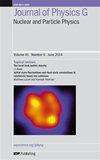中微子-中微子碰撞的物理学案例
IF 3.5
3区 物理与天体物理
Q2 PHYSICS, NUCLEAR
Journal of Physics G: Nuclear and Particle Physics
Pub Date : 2024-03-12
DOI:10.1088/1361-6471/ad2b7d
引用次数: 0
摘要
解决中微子的质量起源和特性问题是粒子物理学、重子发生学和宇宙学非常感兴趣的问题。流行的解释涉及标准模型之外的物理学,例如五维温伯格算子或 "跷跷板 "模型产生的重马约拉纳中微子。目前对电子中微子质量的最佳直接限制来自核β衰变或无中微子双β衰变过程,处于亚电子伏特水平。在这里,我们提出了一个新颖的中微子对撞机,其中的中微子束是由TeV尺度的μ介子衰变产生的。这种对撞可以发生在中微子和反中微子之间,也可以发生在中微子和中微子之间。我们发现,只需约10-5 fb-1的微小综合光度,我们就已经有望观测到直接的中微子反中微子湮灭,νν¯→Z,这也为探索中微子相关共振νν¯→X打开了大门。低照度要求可以容纳相对较大发射率的μ介子束。这样的装置还可以通过νν → HH探测重马约拉纳中微子和有效马约拉纳中微子质量,达到电子和μ介子类型的竞争水平。本文章由计算机程序翻译,如有差异,请以英文原文为准。
The physics case for neutrino–neutrino collisions
Addressing the mass origin and properties of neutrinos is of strong interest to particle physics, baryogenesis and cosmology. Popular explanations involve physics beyond the standard model, for example, the dimension-5 Weinberg operator or heavy Majorana neutrinos arising from ‘seesaw’ models. The current best direct limits on the electron neutrino mass, derived from nuclei beta decay or neutrinoless double beta decay processes, are at the sub-electronvolt level. Here we propose a novel neutrino–neutrino collider where the neutrino beam is generated from TeV scale muon decays. Such collisions can happen between either neutrinos and anti-neutrinos, or neutrinos and neutrinos. We find that with a tiny integrated luminosity of about 10−5 fb−1 we can already expect to observe direct neutrino anti-neutrino annihilation,
ν ν ¯ → Z , which also opens the door to explore neutrino related resonances
ν ν ¯ → X . The low luminosity requirement can accommodate a relatively large emittance muon beam. Such a device would also allow for probing heavy Majorana neutrino and effective Majorana neutrino mass through ν
ν → HH to a competitive level, for both electron and muon types.
求助全文
通过发布文献求助,成功后即可免费获取论文全文。
去求助
来源期刊
CiteScore
7.60
自引率
5.70%
发文量
105
审稿时长
1 months
期刊介绍:
Journal of Physics G: Nuclear and Particle Physics (JPhysG) publishes articles on theoretical and experimental topics in all areas of nuclear and particle physics, including nuclear and particle astrophysics. The journal welcomes submissions from any interface area between these fields.
All aspects of fundamental nuclear physics research, including:
nuclear forces and few-body systems;
nuclear structure and nuclear reactions;
rare decays and fundamental symmetries;
hadronic physics, lattice QCD;
heavy-ion physics;
hot and dense matter, QCD phase diagram.
All aspects of elementary particle physics research, including:
high-energy particle physics;
neutrino physics;
phenomenology and theory;
beyond standard model physics;
electroweak interactions;
fundamental symmetries.
All aspects of nuclear and particle astrophysics including:
nuclear physics of stars and stellar explosions;
nucleosynthesis;
nuclear equation of state;
astrophysical neutrino physics;
cosmic rays;
dark matter.
JPhysG publishes a variety of article types for the community. As well as high-quality research papers, this includes our prestigious topical review series, focus issues, and the rapid publication of letters.

 求助内容:
求助内容: 应助结果提醒方式:
应助结果提醒方式:


